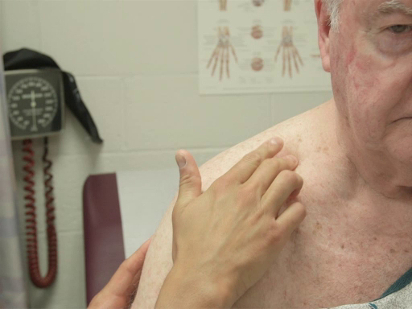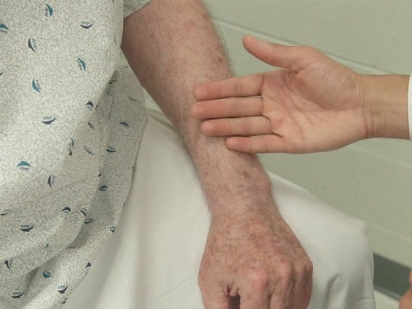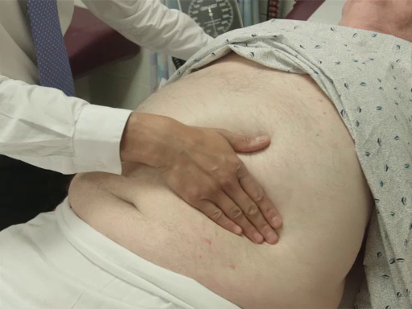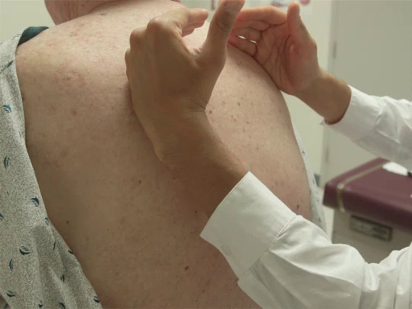מישוש
English
分享
概述
מקור: ג’ייאדיפ ס טלווקר, MD, רפואה פנימית ורפואת ילדים, בית הספר לרפואה של ייל, ניו הייבן, CT
הבדיקה הגופנית דורשת שימוש בכל החושים של הספק כדי לקבל מידע על המטופל. תחושת המגע משמשת להשגת מידע אבחוני באמצעות מישוש.
החלקים הספציפיים של ידו של הבוחן המשמשים למישוש שונים בהתאם לחלק הגוף הנבדק. בשל הפנימיות החושית הצפופה שלהם, רפידות האצבעות שימושיות לאפליה עדינה(למשל,הגדרת גבולות המסות, בלוטות הלימפה) (איור 1). משטח הגעש של היד מספק תחושה גסה של טמפרטורה יחסית(איור 2). משטחי הדקל של האצבעות והידיים שימושיים ביותר לסקר אזורים גדולים בגוף (למשל,בטן)(איור 3). רטט מוערך ביותר עם פני השטח הגומדים של הידיים והאצבעותהחמישיות (למשל,פרמיטוס מישוש)(איור 4).
בעוד מישוש הוא היסוד להיבט האבחוני של הבדיקה הגופנית, חשוב גם להכיר בתפקיד כי מגע משחק בתקשורת אכפתיות ונוחות במהלך המפגש עם המטופל. מטופלים בדרך כלל תופסים מגע מספק שירותי בריאות באור חיובי, ותפיסותיהם לגבי ספק שירותי בריאות יכולות להיות מעוצבות על ידי שימוש מיומן במגע במהלך מפגשים קליניים. 1 מגע פיזי קושר עם שינויים ברמות הנוירוטרנסמיטר ההורמונלי, במיוחד פוחת בקורטיזול ועליות בסרוטונין. 2
לכן, באמצעות שימוש זהיר של מישוש, ומגע בכלל, במהלך הבדיקה הגופנית, לקלינאי יש הזדמנות להשיג מידע אבחוני חשוב, תוך פיתוח קרבה וקידום ריפוי.

איור 1. בדיקת בלוטות לימפה עם רפידות אצבע.

איור 2. שימוש בדורסום של היד כדי להעריך את החום.

איור 3. מישוש בטן עם משטח כף היד של אצבעות וידיים.

איור 4. באמצעות משטח הגומד של היד כדי להעריך את fremitus מישוש.
Procedure
Applications and Summary
This demonstration covered the general considerations related to palpation during the physical examination. While specific techniques vary based on each individual portion of the exam, many general principles related to palpation hold throughout the exam. Attention to patient safety and comfort is achieved through hand-washing, proper grooming, warming of the hands, infection control precautions, and sensitive draping. The correct part of the fingers and hands should be used for different types of palpation, with finger pads being used most commonly during the exam. The clinician should be deliberate about the amount and duration of pressure being applied during palpation; these variables change based on the part of the body being examined and specific patient circumstances. Finally, the clinician should remember the important role that touch plays in the patient encounter in terms of therapeutic value and the clinician-patient relationship. The most direct physical contact during the encounter occurs through palpation, which provides an opportunity to secure the bond the clinician has started to develop during history taking.
References
- McCann, K., McKenna, H.P. An examination of touch between nurses and elderly patients in a continuing care setting in Northern Ireland. Journal of Advanced Nursing. 18, 838-46 (1993).
- Field, T. Violence and touch deprivation in adolescents. Adolescence. 37 (148), 735-749 (2002).
- Verrees, M. Touch me. JAMA. 276 (16), 1285-1286 (1996).
成績單
During a physical exam, the clinician uses the sense of touch through palpation to obtain useful diagnostic information. It is an assessment technique in which the examiner uses the surface of the fingers and hands to feel and examine an organ or body part. While palpation is fundamental to the diagnostic aspect of the physical exam, it is also important to acknowledge the role that touch plays in communicating caring and comfort during the patient encounter.
This video will illustrate the different palpation techniques, and discuss the approach and considerations for this procedure.
First, let’s discuss the different types of palpation techniques that are based on the specific parts of the examiner’s hand used to perform the procedure. Finger pads are used for palpation of most of the body parts. Because of their dense sensory innervation, the finger pads are useful for fine discrimination, for example defining the borders of masses, or while examining the lymph nodes. Fingertips are used for palpating specific structures like the nailbeds, liver edge, and cervix. In addition to fingertips and finger pads, physicians also use the ulnar surface of the hands and fifth fingers to appreciate vibration when performing specialized test like tactile fremitus. One should use the palmar surface of the fingers and hands for assessing functions like chest expansion, palpation of the precordium, light and deep abdominal palpation, and muscle strength testing. Lastly, the dorsal surface of the hands is used for getting rough sense of relative temperature, typically in comparison to another portion of the patient’s body.
Now that you know about different palpation techniques, let’s discuss the general approach to palpation during any clinical exam.
Before every patient encounter, make sure that your fingernails are clean, groomed, and trimmed. Wash your hands with soap and water or apply topical disinfectant solution. Warm your hands either with warm water or by rubbing them together. If any specific infection control precautions are needed, then wear the protective equipment and explain to the patient why it’s necessary. Remember: gowns, gloves, and masks can present a barrier to building a relationship with the patient.
In order to gauge the patient’s comfort with the clinician’s touch, you may start the examination with the hands. First, perform palpation of the nailbeds with your fingertips to assess for capillary refill and pallor. Then, palpate the radial pulse with your finger pads. After that, move to the anatomic region of interest, in this case the abdominal region. Employ draping techniques to optimize access, while balancing patient’s modesty. Next, ask the patient to point to the area of discomfort. Consider palpating it towards the end, making it clear to patients this is done in the interest of their comfort, “I’m going to examine this area last in order just to make it more comfortable for you.”
In general, be aware of the pressure used for palpation, which varies based on the structures being examined. For example, insufficient pressure may limit one’s ability to palpate deep structures, and excessive pressure may occlude a pulse, causing discomfort and limiting utility. Be deliberate about the palpation duration as well, which again differs based on the structure under examination. For example, while examining the lower extremities, the palpation needs to be performed for sufficient amount of time to reveal pitting edema, if present. This kind of information can be missed if palpation duration is insufficient. In addition, express empathy while acknowledging that examination of certain parts may cause the patient discomfort. Although patient expects to be examined, always ask permission and provide a warning if you are about to do something that may worsen the pain. At the end of the exam, drape the patient back and thank them for their cooperation.
You’ve just watched JoVE’s introduction to palpation. This demonstration covered the types and general considerations related to palpation during a physical exam. Through the careful use of this technique, the clinician has the opportunity to gain important diagnostic information, while developing rapport and promoting healing. As always, thanks for watching!
